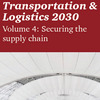 This is the first paper that sparked my research interest in transportation vulnerability, and what would later become the focus area of my research: the cost of transportation vulnerability and the benefit of transportation reliability. It was published almost ten years ago, in 2001: Risk and Impact of Natural Hazards on a Road Network by Erica Dalziell and Alan Nicholson from the University of Canterbury, Christchurch, New Zealand. As far as I am aware of, the Dalziell-Nicholson paper is one of the first attempts to calculate a cost benefit ratio for road closure versus mitigation investments, where the road is seen as a transportation lifeline, and thus a critical infrastructure for the communities that it links.
This is the first paper that sparked my research interest in transportation vulnerability, and what would later become the focus area of my research: the cost of transportation vulnerability and the benefit of transportation reliability. It was published almost ten years ago, in 2001: Risk and Impact of Natural Hazards on a Road Network by Erica Dalziell and Alan Nicholson from the University of Canterbury, Christchurch, New Zealand. As far as I am aware of, the Dalziell-Nicholson paper is one of the first attempts to calculate a cost benefit ratio for road closure versus mitigation investments, where the road is seen as a transportation lifeline, and thus a critical infrastructure for the communities that it links.
The importance of road links
I must admit that I feel guilty for not posting for a while. The reason is simply that I’ve been swamped with work lately, finishing a report on a work project related to a previous post on Bad Locations – Bad Logistics?, dealing the cost of disruptions in freight transport. The report will hopefully spin off into a book chapter and a journal paper, or at least a conference paper, so I hope. Let alone some posts for this blog. It was when writing the literature study section of the report that I remembered the very first paper I read on transportation vulnerability. It is a paper that shows how to attach a value to the importance of road links.
The New Zealand Desert Road
 The paper is centered around the impacts of closing the Desert Road in New Zealand. The Desert Road is a 52 km stretch of the 2047 km long State Highway 1, that traverses the full length of New Zealand’s North and South islands. At km 794 on the Desert Road, State Highway 1 is 1,074 metres (3,520 ft) above sea level – the highest point on the New Zealand State Highway network., and thus subject to extreme weather conditions in winter, causing frequent closures. It also passes within 15km of three active volcanoes Mt. Ruapehu, Mt. Ngauruhoe and Mt. Tongariro, with the first being the most active having a return period of 0.25 – 0.75 years, potentially closing the road due to bridge damage or flooding caused by lahars (View Google Map).
The paper is centered around the impacts of closing the Desert Road in New Zealand. The Desert Road is a 52 km stretch of the 2047 km long State Highway 1, that traverses the full length of New Zealand’s North and South islands. At km 794 on the Desert Road, State Highway 1 is 1,074 metres (3,520 ft) above sea level – the highest point on the New Zealand State Highway network., and thus subject to extreme weather conditions in winter, causing frequent closures. It also passes within 15km of three active volcanoes Mt. Ruapehu, Mt. Ngauruhoe and Mt. Tongariro, with the first being the most active having a return period of 0.25 – 0.75 years, potentially closing the road due to bridge damage or flooding caused by lahars (View Google Map).
Hazards and closure duration
 The paper is based on Erica Dalziell’s PhD thesis, and unfortunately for the investigative reader, the paper itself does not contain any details as to which particular hazards that were considered along with their corresponding event magnitude, duration, and probability. The reader is simply referred to the PhD thesis. That said, the paper displays that it is based on solid empirical and stochastic data, showing examples of Monte Carlo simulations for event occurrence and event duration.
The paper is based on Erica Dalziell’s PhD thesis, and unfortunately for the investigative reader, the paper itself does not contain any details as to which particular hazards that were considered along with their corresponding event magnitude, duration, and probability. The reader is simply referred to the PhD thesis. That said, the paper displays that it is based on solid empirical and stochastic data, showing examples of Monte Carlo simulations for event occurrence and event duration.
Traffic flow and Closure Cost
In terms of closure cost, Dalziell follows the traditional approach of calculating the increase in generalized travel cost, looking at various scenarios for alternative routes, and the decrease in trips based on the travel demand elasticity in these scenarios. Interestingly, she defines the elasticity as
– (rp + rp-1 + … + r2 + r)
where r = ratio of cost of travel with all links open, to the cost of travel with one or more road links closed. This is contrary to the traditional measure of elasticity, expressed as
% change in number of trips / % change in cost of trip.
The elasticity parameter p is estimated from the predicted traffic flows versus observed flows during a road closure (with road closures apparently occurring rather frequently on this road, there is sufficient data for observed flows).
The total cost of road closures is assumed to be the sum of
- The change in vehicle operating costs
- The lost user benefit from those trips that are cancelled or suppressed
- The change in accident costs
Note here that the traffic model assumes that all travellers have perfect knowledge of the road situation at the start of their travel. This will not always be the case, and some travellers may be caught by a road closure while travelling, such that the may have passed the junction with the best available alternative and may have to go back (at a higher cost) or cancel their trip altogether (lost benefit). This means that the total costs are usually underestimated, but it is still the best estimate available.
Using Mone Carlo simulation, the cumulative frequencies of the annual road closure costs for the range of hazard and closure scenarios can then be estimated.
Cost-benefit and mitigation
A road closure will have a cost associated with it, so will a mitigation effort, e.g better snow clearing equipment. The issue is whether the benefit of mitigating will offset the cost of closure. The worth of the mitigation will depend on its ability to reduce the probability and/or cost of road closure. Thus, since mitigation efforts do affect the probability and impact of closures, it is necessary to re-calculate the scenarios with the mitigation option in place. It is not simply a matter of road closure costs versus mitigation costs, but rather a matter of expected closure costs with mitigation place versus expected closure costs without the mitigation in place, compared to the capital and maintenance costs of the mitigation option.
Conclusion
 The strength of this paper lies in its simplicity. What lies behind it, the probability estimates for each hazard, the simulations and laborious calculations are not shown (except for the resulting figures, graphs and diagrams), and for the sake of the argument, they do not matter. The paper also shows that in order to estimate costs and benefits of mitigating road closures, a system-wide approach is necessary, the estimation cannot confine itself to just the affected stretch of road or the immediate affected communities, it needs to encompass the whole network, since the effects may cascade through other not-intended parts of the road network. It is also important to use simulations and probability functions for arriving at correct estimates, and it is important to account for travel demand elasticity.
The strength of this paper lies in its simplicity. What lies behind it, the probability estimates for each hazard, the simulations and laborious calculations are not shown (except for the resulting figures, graphs and diagrams), and for the sake of the argument, they do not matter. The paper also shows that in order to estimate costs and benefits of mitigating road closures, a system-wide approach is necessary, the estimation cannot confine itself to just the affected stretch of road or the immediate affected communities, it needs to encompass the whole network, since the effects may cascade through other not-intended parts of the road network. It is also important to use simulations and probability functions for arriving at correct estimates, and it is important to account for travel demand elasticity.
References
Dalziell, E., & Nicholson, A. (2001). Risk and Impact of Natural Hazards on a Road Network Journal of Transportation Engineering, 127 (2) DOI: 10.1061/(ASCE)0733-947X(2001)127:2(159)
Author links
- canterbury.ac.nz: Alan Nicholson
- rsrc.co.nz: Erica Seville, nee Dalziell
Related
- husdal.com: Bad locations – Bad logistics?
- husdal.com: Are roads more important than computers?
- husdal.com: The reliability and vulnerability of transportation lifelines












